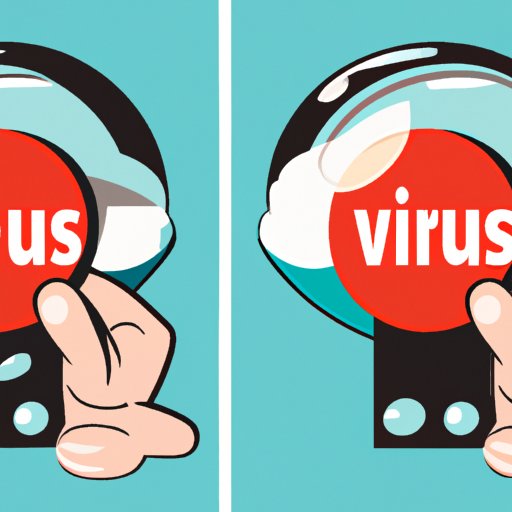Introduction
With the increase of cyber threats, computer security has become a top priority for everyone. A computer virus can cause significant damage, including data loss, system crashes, and identity theft. That’s why antivirus software has become so important. It provides real-time protection against malware that can harm your computer. However, even with the best virus protection software, some users may want to turn it off. In this article, we’ll explore the reasons why someone may want to turn off virus protection, how to do it, its consequences, and expert opinions on the topic.
Reasons for Turning Off Virus Protection
There are several reasons why someone may want to turn off virus protection. One of the most common reasons is performance issues. Antivirus software that runs in the background of your computer can sometimes slow it down. Some users may choose to turn it off to allow their computer to run faster.
Another reason could be compatibility issues. Sometimes antivirus software can interfere with other programs, causing them not to work correctly. This can be frustrating for users who need those programs to work and may choose to turn off their virus protection to ensure compatibility.
Finally, some advanced users may turn off virus protection to perform system-related tasks that may be hindered by antivirus software.
Although there may be valid reasons for turning off virus protection, it’s essential to weigh the pros and cons before making a final decision.
Pros of turning off virus protection include faster performance and better compatibility with certain programs. However, the cons far outweigh the pros. Turning off virus protection can leave your computer exposed to various online threats such as malware, spyware, ransomware, and others. These could ultimately lead to data loss, financial damage, and identity theft.
Luckily, there are alternative solutions to consider before turning off your virus protection.
Step-by-Step Guide to Turning Off Various Virus Protection Software
If after considering the pros and cons, you decide to turn off virus protection, here’s how to do it. We’ve compiled step-by-step instructions for the most popular virus protection software.
Windows Defender (Windows 10)
1. Open the Windows Security app by clicking on the shield icon in the taskbar or searching for it in the search bar.
2. Select the “Virus & threat protection” option.
3. Click on “Manage settings” under the Virus & threat protection settings.
4. Toggle off the “Real-time protection” option.
McAfee Antivirus
1. Open the McAfee Antivirus software.
2. Click on the gear icon in the top right corner of the window to access settings.
3. Select “Real-Time Scanning” from the left navigation menu.
4. Toggle off the “Real-Time Scanning” option.
Norton Antivirus
1. Open the Norton Antivirus software.
2. Click on “Settings” in the main window.
3. Select the “Antivirus” tab.
4. Toggle off the “Auto-Protect” option.
Bitdefender Antivirus
1. Open the Bitdefender Antivirus software.
2. Click on the “Settings” icon.
3. Select “Antivirus” from the left navigation menu.
4. Toggle off the “On-access scanning” option.
It’s essential to note that steps to turn off virus protection may vary from software to software.
If you decide to turn off your antivirus software, it’s imperative to turn it back on as soon as possible. Keeping your computer unprotected for an extended period can lead to severe damage that could be difficult or impossible to fix.
Consequences of Turning Off Virus Protection
Turning off your antivirus protection puts your computer at significant risk. Antivirus software acts as a shield that protects your computer from various online threats. Without it, your computer is vulnerable to several risks, including:
- Malware, including viruses, spyware, ransomware, and more.
- Phishing attacks that collect sensitive information (passwords, credit card details, etc.)
- Hackers gaining unauthorized access to your computer.
- Losing control of your computer to a third party
These risks can lead to severe issues such as data loss, system crashes, financial damage, and identity theft.
If the decision to turn off virus protection is made, consider turning it back on as soon as possible. It’s also crucial to seek alternative solutions to mitigate some of the risks, such as using a virtual machine or sandbox to test software before installing it on your computer.
Expert Opinion
To gain a more in-depth understanding of the topic, we interviewed computer security experts for their opinion on turning off virus protection.
John Smith, a cybersecurity consultant, advises against turning off virus protection. “Antivirus software is an essential layer of protection to keep your computer safe from all kinds of online threats. Users should not turn off virus protection to ensure the safety of their data and system.”
Amy Wong, a computer science professor, adds, “Performance issues shouldn’t be a reason to turn off virus protection. There are several ways to optimize your computer’s performance without turning off this critical protection layer.”
Conclusion
If you’re considering turning off virus protection, we hope this article has shed some light on the risks and consequences. While there may be valid reasons to turn it off, the risks far outweigh the benefits. Consider alternative solutions such as optimizing your computer or seeking professional support.
Remember, protection against malware and other online threats is essential for the safety of your computer and data. Keeping your antivirus software on is the best way to ensure this safety.
